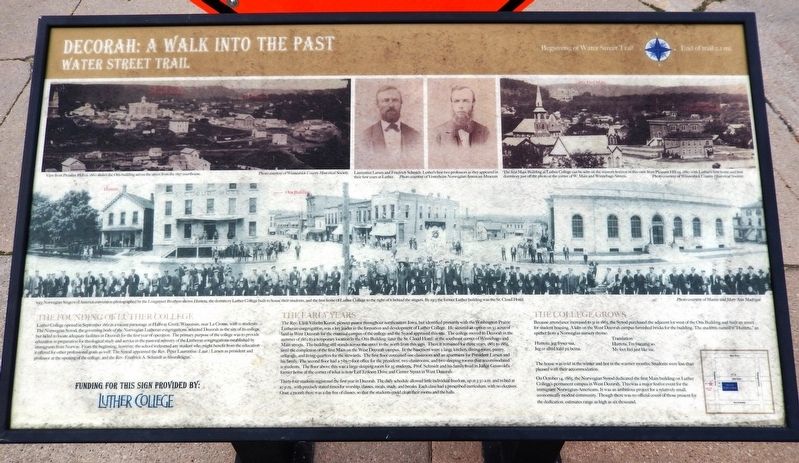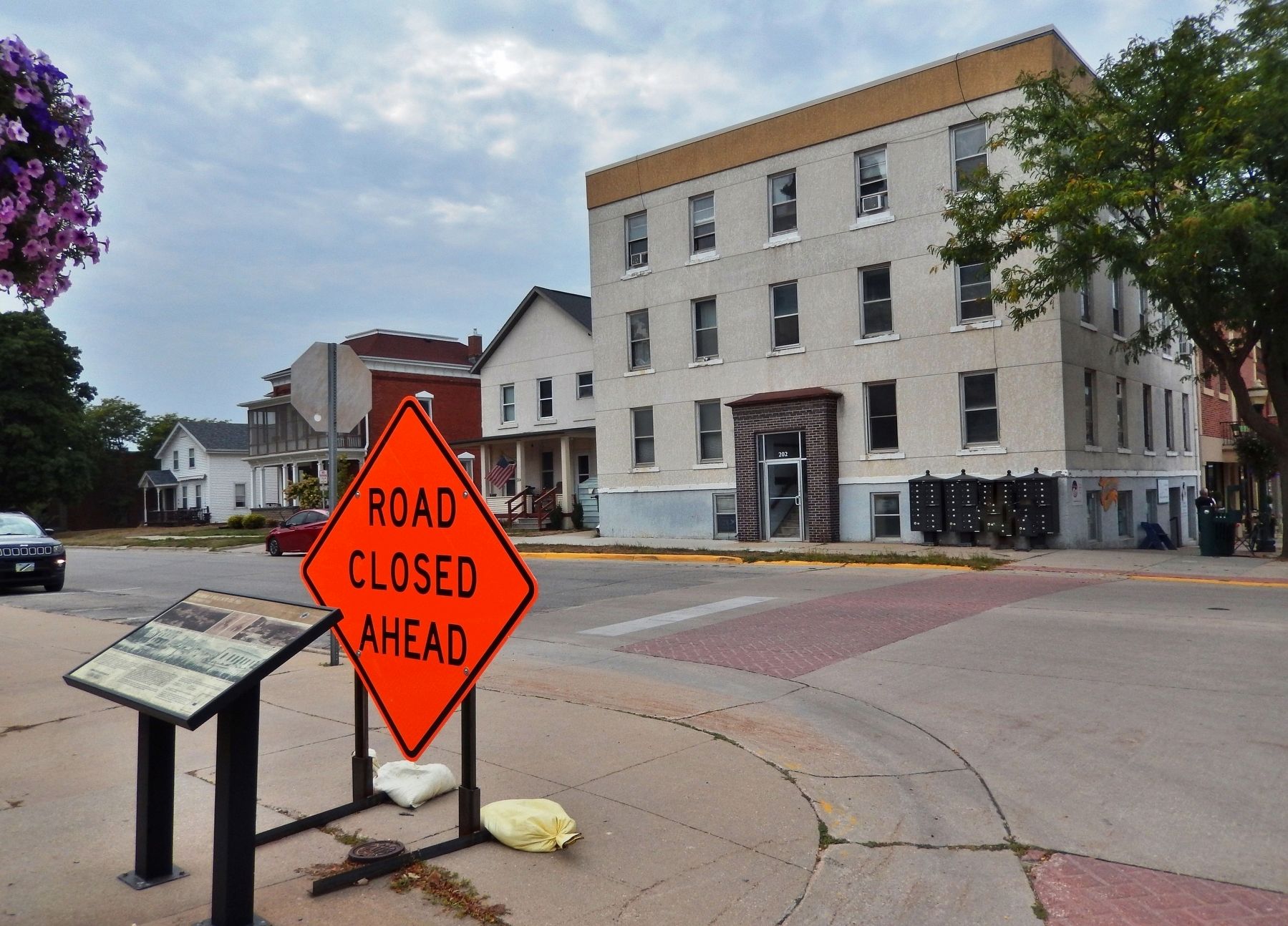Decorah in Winneshiek County, Iowa — The American Midwest (Upper Plains)
Decorah: A Walk into the Past
Water Street Trail
The Founding of Luther College
Luther College opened in September 1861 in a vacant parsonage at Halfway Creek, Wisconsin, near La Crosse, with 11 students. The Norwegian Synod, the governing body of the Norwegian Lutheran congregations, selected Decorah as the site of its college, but failed to locate adequate facilities in Decorah for the first year of operation. The primary purpose of the college was to provide education in preparation for theological study and service in the pastoral ministry of the Lutheran congregations established by immigrants from Norway. From the beginning, however, the school welcomed any student who might benefit from the education it offered for other professional goals as well. The Synod appointed the Rev. Peter Laurentius (Laur.) Larsen as president and professor at the opening of the college, and the Rev. Friedrich A. Schmidt as his colleague.
The Early Years
The Rev. Ulrik Vilhelm Koren, pioneer pastor throughout northeastern Iowa, but identified primarily with the Washington Prairie Lutheran congregation, was a key leader in the formation and development of Luther College. He secured an option on 32 acres of land in West Decorah for the eventual campus of the college and the Synod approved this site. The college moved to Decorah in the summer of 1862 to a temporary location in The Otis Building (later the St. Cloud Hotel) at the southeast corner of Winnebago and Main streets. The building still stands across the street to the north from this sign. There it remained for three years, 1862 to 1865, until the completion of the first Main on the West Decorah campus. In the basement were a large kitchen, dining room, pantry, cellarage, and living quarters for the stewards. The first floor contained one classroom and an apartment for President Larsen and his family. The second floor had a 7-by-7-foot office for the president, two classrooms, and two sleeping rooms that accommodated students. The floor above this was a large sleeping room for 25 students. Prof. Schmidt and his family lived in Judge Griswold’s former home at the corner of what is now Leif Erikson Drive and Center Street in West Decorah.
Thirty-four students registered the first year in Decorah. The daily schedule allowed little individual freedom, up at 5:30 a.m. and in bed at 10 p.m., with precisely stated times for worship, classes, meals, study, and breaks. Each class had a prescribed curriculum, with no electives. Once a month there was a day free of classes, so that the students could clean their rooms and the halls.
The College Grows
Because attendance increased to 51 in 1863, the Synod purchased the adjacent lot west of the
Otis Building and built an annex for student housing. A kiln on the West Decorah campus furnished bricks for the building. The students named it “Huttetu,” an epithet from a Norwegian nursery rhyme:
Huttetu, jeg fryser saa,The house was cold in the winter and hot in the warmer months. Students were less than pleased with their accommodation.
Jeg er alltid kald pa beina.
Translation:
Huttetu, I'm freezing so.
My feet feel just like ice.
On October 14, 1865, the Norwegian Synod dedicated the first Main building on Luther College's permanent campus in West Decorah. This was a major festive event for the immigrant Norwegian-Americans. It was an ambitious project for a relatively small, economically modest community. Though there was no official count of those present for the dedication, estimates range as high as six thousand.
[photo captions]
• View from Pleasant Hill ca. 1860 shows the Otis building across the street from the 1857 courthouse.
• Laurentius Larsen and Friedrich Schmidt, Luther’s first two professors as the appeared in their first years at Luther.
• The first Main Building at Luther College can be seen on the western horizon in this view from Pleasant Hill ca. 1880 with Luther’s first home and first dormitory just off the photo at the corner of W. Main and Winnebago Streets.
• 1913 Norwegian Singers of America convention photographed by the Longstreet Brothers shows Huttetu, the dormitory Luther College built to house their students, and the first home of Luther College to the right of it behind the singers. By 1913 the former Luther building was the St. Charles Hotel.
Funding for this sign provided by: Luther College
Topics. This historical marker is listed in these topic lists: Architecture • Churches & Religion • Education • Immigration. A significant historical month for this entry is September 1861.
Location. 43° 18.191′ N, 91° 47.237′ W. Marker is in Decorah, Iowa, in Winneshiek County. Marker is at the intersection of West Main Street and Winnebago Street, on the right when traveling east on West Main Street. The marker is located along the sidewalk near the southwest corner of the intersection. Touch for map. Marker is at or near this postal address: 201 West Main Street, Decorah IA 52101, United States of America. Touch for directions.
Other nearby markers. At least 8 other markers are within walking distance of this marker. Winnebago Street (a few steps from this marker); "The Biggest Day in the History of the County" (within shouting distance of this marker); Replica of the Statue of Liberty (within shouting distance of this marker); Decorah, Northeast Iowa, & the Neutral Ground (about 300 feet away, measured in a direct line); To Build, or Not To Build (about 300 feet away); a different marker also named Decorah: A Walk into the Past (about 300 feet away); a different marker also named Decorah: A Walk into the Past (about 400 feet away); a different marker also named Decorah: A Walk into the Past (about 400 feet away). Touch for a list and map of all markers in Decorah.
Also see . . .
1. Luther College History. Excerpt:
In the summer of 1862 the school was transferred to Decorah; its first home was the building, still standing, at the northwest corner of Winnebago and Main streets. Though college work was begun in 1861, the Civil War, illness, and other causes left none of that year’s freshman class to graduate in 1865. The first graduating class, therefore, was that of 1866. The classical curriculum established by the founders of the college was changed in 1932 when the requirement that all students take both Greek and Latin was dropped. For 75 years the school admitted men only; then, in 1936, Luther College became coeducational. When the institution celebrated its centennial in 1961, it had an enrollment of 1,357 and a staff of 74 full-time and 12 part-time teachers.(Submitted on February 29, 2024, by Cosmos Mariner of Cape Canaveral, Florida.)
2. Luther College (Wikipedia). Excerpt:
In 1964, Luther's museum collection became separate from the college and was established as the Norwegian-American Museum. Now known as Vesterheim Norwegian-American Museum, it is the largest and most comprehensive museum in the United States devoted to a single immigrant group. Nordic Fest, started in 1967, grew from Luther College Women's Club's annual celebration of Norwegian Constitution Day.(Submitted on February 29, 2024, by Cosmos Mariner of Cape Canaveral, Florida.)
Credits. This page was last revised on February 29, 2024. It was originally submitted on February 29, 2024, by Cosmos Mariner of Cape Canaveral, Florida. This page has been viewed 51 times since then. Photos: 1, 2. submitted on February 29, 2024, by Cosmos Mariner of Cape Canaveral, Florida.

